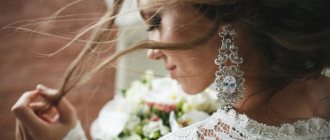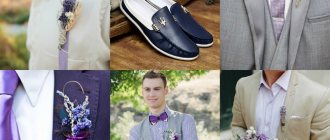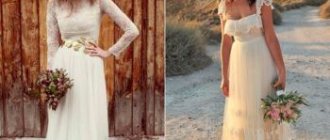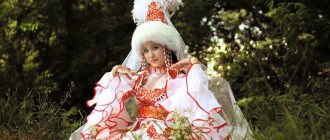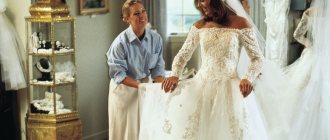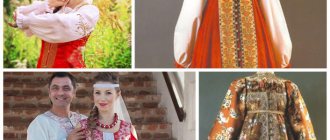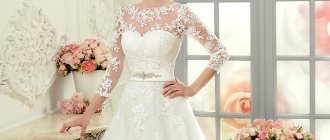In Ancient Rome, the bride's attire was very modest
To hide the girl’s beauty, she had to wrap herself in ordinary woolen blankets, but the groom was given a white outfit. During the Renaissance, wedding dresses in bright colors (red, bright yellow, orange) became popular. Wedding suits were decorated with lace and rich gold-colored embroidery. However, there were also more modest outfits in black, embroidered with silver thread.
In the 17th and 18th centuries, openwork lace, which was used to decorate skirts with numerous frills and bodices, became a mandatory attribute for decorating a wedding dress. Lush dresses with Medici collars and luxurious embroidery, lace trim or expensive fur were fashionable. The groom's wedding dress was decorated with a collar and cuffs made of lace. Different tones could be used (from delicate pastels to bright ones). The most popular colors were soft pink, light blue and green.
Girls from ordinary families walked down the aisle in gray dresses. Brown and beige outfits have become fashionable for going to church on Sundays.
Baroque style
A style came into fashion in the 13th century, which was characterized by outfits in silvery and delicate tones: light blue, light pink, light green, beige, cream, lilac, marble. The corsets strongly support the chest, and the wide skirts worn by Pannier. The most popular accessories used are feathers, lace, pearls, artificial flowers, fans and cameos. A bouffant hairstyle with feathers or flowers completes the look.
KNOWLEDGE BASE: Wedding dresses in a romantic style: tenderness, sophistication and airiness
Baroque brides whitened their faces to such an extent that they looked like porcelain dolls. This style is suitable for girls who dream of looking like a princess at a celebration.
By the end of the 18th century, the Rococo style became fashionable
Newlyweds appreciated wedding dresses with a silver tint. The lush bottom was decorated with frills and ribbons, and also, for splendor, frames made of rods (willow, steel or plates made of whalebone) were used. To make the bride's waist look as thin as possible and her chest to become fuller, tight corsets were used. The bride's status was emphasized by a long train and sleeves.
In addition, at this time, the empire style became fashionable - straight-cut dresses with a high waist, which emphasized the sophistication and charm of the newlywed.
In the 19th century, wedding fashion changed very rapidly.
White color for wedding dresses came into fashion during the time of Queen Victoria of England. She was the first to shine at the wedding in a snow-white dress and veil, embroidered with luxurious golden lace. Subsequently, this style became known as “Victorian”. In those days, wedding dresses were simple and strict styles, no deep neckline, open shoulders or back. Even the newlywed's hands had to be covered with long sleeves and dressed in lace gloves. The bride's head was decorated with a long lace veil complete with an orange blossom wreath, symbolizing the girl's innocence and chastity. By the end of the century, wedding fashion had undergone some changes, as a result of which the skirts of wedding dresses became flowing and light, and the brides themselves resembled elegant porcelain figurines.
Wedding dress 1910
emphasized the sophistication and elegance of its owner. As a rule, these were loose-fitting dresses with lace sleeves, complemented by a veil and long gloves. Newlyweds of this time preferred closed outfits and a minimum of cosmetics. In 1920, shorter wedding dresses became fashionable than ten years later. Arm-baring and V-neck styles were especially popular.
Most often, brides used pearl threads as decoration. Wedding fashion corresponded to the clothing style characteristic of that time. Most brides preferred a white dress with a straight cut, low waist and high neckline. A veil of openwork lace completed the look. Brides of the 1930s favored glamorous A-line and fishnet styles made from shiny faux fabrics.
Brides of the gloomy 1940s, most often, were dressed in ordinary beautiful outfits, which they sewed themselves for the wedding. In 1945, dresses with long sleeves and gathered, voluminous shoulders became especially popular. The style is quite simple, but effective, emphasizing the thin waist. Pearls were most often used as decoration. The look was completed with light makeup on the upper part of the face and bright lipstick.
What dresses were worn to weddings in the old days?
In the Middle Ages, representatives of powerful families often married not for love, but for political reasons. It is clear that the girl at the wedding had to look simply stunning, because the honor and wealth of the entire family were assessed by her outfit. At that time, exquisite and expensive fabrics were used to sew wedding dresses - silk, satin, tulle and corduroy, which were generously decorated with embroidery with gold threads and valuable fur.
In accordance with the customs of that period, the outfits were closed, and the hemlines and sleeves had a maximum length. The paints of that era were made from natural ingredients, so only representatives of wealthy families could afford bright shades (scarlet, blue, pink). Dresses of natural “earthly” colors were widely used by poor girls.
Expensive dresses were decorated with jewelry: pearls, diamonds, emeralds, sapphires. Sometimes there was so much decoration that the material of the dress itself was practically hidden from the eyes of outside observers. They say that Countess Margaret of Flanders wore a very rich dress, decorated with thousands of jewels, for her own wedding ceremony. She didn’t even have the strength to take a few steps; the countess was literally carried into the church.
Starting from the 17th century, weddings already played a dynastic role. However, brides did not stop trying to impress guests with their own outfit. But sometimes people did not appreciate their choice; fashion differed in different countries. For example, the Portuguese princess Catherine of Braganskaya came to her wedding with the English king in a pink wedding dress with an internal frame, fashionable in her homeland. But the British reacted dryly. True, later the fashion for such outfits reached England.
18 century
In the eighteenth century, girls from middle-class families wanted their wedding attire to look rich. For this purpose, dresses were often trimmed with natural fur. Mink or sable fur was an expensive option, while hare or fox fur was a more economical option. Representatives of poor families could simply use linen instead of the usual rough fabric from which ordinary clothes and even linen were made. And the length of the train and sleeves was a sign of the newlywed’s status.
For girls from ordinary families, their wedding attire often remained a “weekend” outfit and was worn by them on every significant holiday. Interestingly, the shade of the dress played a big role. There were many superstitions and prejudices regarding color. For a wedding dress, brides in the 18th century mainly chose the following shades: blue and pink.
White, despite its associations with purity and purity, was an impractical color, because such an outfit was very easy to get dirty. In this regard, the color blue was often used for wedding attire. He was associated with the innocence of the Virgin Mary. This is where the custom of taking something blue with you to a wedding ceremony arose in English-speaking countries. Pink was also common.
So, in the 18th century, the wife of the British sculptor Joseph Nolekes dressed up for her own wedding in a light openwork white dress with flowers embroidered with pink threads. Shoes decorated with floral embroidery were also chosen to match it. The heel was very high for that time - as much as 8 centimeters. Incredibly, everyone present liked the girl’s outfit.
Shades of red were not used for wedding dresses for a long time. People tend to associate this tone with slutty women. A similar fate awaited the green color - it was considered the color of forest spirits, elves and fairies. In order not to attract unnecessary attention to the young woman, they tried to avoid such shades. Black was considered mournful. At some weddings, even guests were not allowed to wear black clothes, so as not to cause unnecessary trouble.
The brown tone has been used by poor brides for decades, and yellow was just reaching the peak of its popularity. Three centuries ago it was fashionable, but was considered the characteristic color of the pagans, so the church did not perceive it particularly well. In poorer strata of society, gray color was also used for wedding dresses, primarily due to practicality. After about a hundred years, he began to be associated with servants.
19th century
At the beginning of the 19th century, a new tradition appeared - decorating wedding dresses with multi-colored ribbons. They were needed so that guests, after tearing off the ribbon, would keep it as a souvenir. Later they were replaced by flowers. Guests came to congratulate the newlyweds with beautiful bouquets, and the young wife’s accessory was a special wedding composition. Flowers could also be attached to the dress or in the bride’s hair. Rosemary, myrtle, and orange blossom were widely used. The tradition is still alive today.
The first wedding dresses, vaguely similar to modern models, began to be sewn at the turn of the 18th and 19th centuries. Then machine production of fabric began, and the import of material from India gained momentum. Dresses with a veil became popular. In the middle of the century, openwork gloves and various precious stones began to be widely used. Among minerals, pearls and natural crystal were especially popular, and satin was used for fabrics. By the end of the century, tight skirts became fashionable.
The real boom in wedding fashion occurred in the 50s of the 20th century.
when outfits with full skirts and necklines, complemented by a veil and short gloves, became popular.
Models that revealed shoulders and strapless dresses appeared, however, there were few brave brides who chose this style. Another 10 years later, short wedding dresses made of cotton, silk and taffeta became popular, and fashionistas replaced the traditional veil with a small hat with a veil or simply decorated their hair with flowers. Many brides chose wedding dresses with short sleeves complete with an airy veil. Designers of that time began to offer newlyweds styles decorated with ribbons, beautiful floral embroidery, lace, as well as luxurious models embroidered with pearls and beads. Bright lipstick has lost its relevance, replaced by matte pale colors and expressive eye makeup. In 1970, the traditional veil lost some of its popularity, but wide-brimmed hats came into fashion, which complemented wedding dresses made from flowing fabrics and, which became popular again, lace fabrics.
Wedding fashion of the 1980s was characterized by luxury and elegance. Brides are again choosing lush dresses, complemented by a long veil and tiara. The image of a beautiful bride of that period was perfectly presented by Princess Diana. The 1990s were characterized by dresses with tight-fitting silhouettes, ball gowns, complemented by a small wedding bouquet, and minimal makeup. In the next decade, brides continue to embrace slim and straight silhouettes, moving away from the classic veil. This accessory is replaced by flower crowns and tiaras. Stylish models with open shoulders are becoming the most popular. Shiny materials (for example, satin or silk) are coming into fashion, but lace is again, undeservedly forgotten.
Vintage wedding dresses
join the discussion
Share with your friends
From time immemorial, a wedding for a woman was something more than a celebration and a holiday date on the calendar. Consequently, the choice of a wedding dress was approached with greater diligence than any other outfit. It will be interesting to know that white was not always associated with weddings. Previously, brides preferred completely different colors. And the styles were very different from those we are used to seeing on brides. An excursion into the bygone world of wedding fashion promises to be interesting, exciting and sometimes even filled with surprise.
Lace
In England there is a sign that on her wedding day the bride should wear “Something old and something new, something borrowed and something blue.” .
Something old is lace that was passed down from grandmothers. They were very expensive - some were more expensive than gold. The wedding dress of American actress Grace Kelly (she got married in 1956) was decorated with lace that was more than 100 years old. Lace is well preserved, so you can often find whole lace from unpreserved dresses in antique shops.
New is jewelry given by the groom. Queen Victoria, seven years after the wedding, commissioned a portrait in which she was depicted in a wedding dress and a brooch, which her husband gave her.
As for borrowing, it was considered a good omen to borrow something from a friend, and something blue was a tribute to the old fashion, when dresses of this color were popular. It was believed that blue was a heavenly color, the color of the Virgin Mary, and it was sure to bring happiness.
The lace was woven using special devices - bobbins.
. The portrait of “The Lacemaker” by Tropinin depicts French bobbins, since, most likely, the lacemaker worked for the nobles. Of the Russian laces, we know only those from Vologda, although there were many lace-making centers. Even if our lacemakers made thin, beautiful lace, it was still put in a French box and passed off as foreign - it was believed that it was better than Russian.
Tropinin A.V. "The Lacemaker"
Main fashion trends
The rich decoration of the bride testified to the wealth of her family, so the most expensive fabrics were chosen to create the wedding dress. Often it was silk or tulle, satin or corduroy. The fabric was richly decorated with gold threads and valuable natural fur.
The morals of past times were strict and required the bride to choose as closed a dress as possible. The maximum length was present not only on the skirt, but also on the sleeves.
Natural colors were common, since they were created using only natural ingredients. A bright wedding dress of scarlet, blue or pink could only be found on a very wealthy bride.
Expensive wedding dresses were decorated with all sorts of jewels. Pearls, diamonds, sapphires and emeralds were used. Their number was sometimes so large that it was difficult to see the fabric of the dress itself.
The most striking proof of this fact is the wedding of Countess Margaret of Flanders, whose dress was very heavy due to the large amount of jewelry. They numbered in the thousands. It was impossible to walk in such a dress, so they carried her to church.
